A Practical Guide to Organizing Your Paper Document Archive
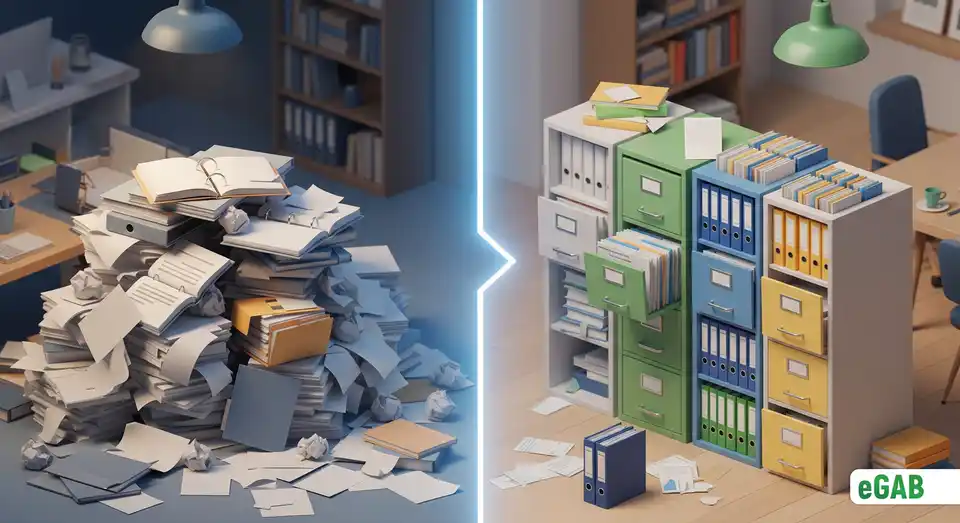
 Author:
Artem Grigoriev
Author:
Artem Grigoriev
- Why a Disorganized Archive Is Costing You Time and Money
- How to Prepare Your Documents for Archiving
- How Do You Design an Effective Filing System?
- A Fully Integrated Digital Wallet for Students
- How to Maintain and Secure Your Organized Archive
- How eGAB Makes Document Organization Effortless and Intelligent
- Summary: Transforming Paper Chaos into a Secure and Efficient Asset
Let's be honest-we've all felt that familiar sinking feeling. You're frantically digging through chaotic stacks of paper, searching for that one critical document you know is lurking somewhere in the office.
This frustrating daily scavenger hunt isn't just an annoyance. It's a silent drain on your company's time and money, representing the true cost of a paper-based workflow, and a clear sign that your paper document management system is failing.
A well-organized paper document archive , however, is the answer. It transforms this chaos into a streamlined and efficient office filing system , helping you move from chaos to clarity. It's the key to reclaiming lost productivity and securing your business's most valuable information.
This practical guide will walk you through the entire process. We'll cover everything from sorting and responsibly getting rid of old records to designing an intuitive filing method. You'll also learn how to create a clear and effective labeling system and, finally, how to maintain your organized archive for years to come.
📘 This post is part of our comprehensive guide to "The Problems with Paper Documents: A Complete Guide". Explore it to find answers to all your questions ;)
Why a Disorganized Archive Is Costing You Time and Money
Have you ever had that sinking feeling when your workday turns into a frustrating scavenger hunt for a single piece of paper? That daily struggle is a clear sign of poor paper document management , and it’s far more common than you might think. No, you’re not imagining it; a disorganized paper archive is a silent killer of productivity. While it might feel like a small annoyance, the truth is this "information chaos" leads to huge losses. The entire field of records management , championed by organizations like ARMA International, was created to fight this exact problem. This isn't just a hassle; groundbreaking research from experts at the Association for Intelligent Information Management (AIIM) shows it’s a massive financial drain. In fact, this disorganization costs businesses thousands of dollars per employee every year in wasted time. If you want to dive deeper, AIIM's guide on Information Management is a fantastic resource.
Let’s break down what that chaos actually looks like. In a typical office that still uses manual filing, a shocking 7.5% of all paper documents are lost for good. On top of that, another 3% of those documents are misfiled. Think about that for a second. It means that over 10% of your company's institutional knowledge-the collective information and experience of your team-is either totally unreliable or has simply vanished. The financial hit is just as painful. It costs an average of $20 just to file one document. Finding a misfiled one costs an estimated $120 . And recreating a file that's gone missing completely? That costs a staggering $220 .
This is exactly why so many of us feel like we spend our days searching for things instead of actually working. In fact, an in-depth productivity analysis shows that some professionals spend up to 50% of their valuable time just trying to find the information they need to do their jobs. And what usually happens when a critical document can't be found? An incredible 83% of employees eventually just give up the search. They decide to recreate it from scratch. This frustrating cycle leads to a nightmare of duplicate work and widespread confusion over which version of a document is the right one. It's a total drain on your team's productivity. Your company's messy filing cabinets aren't just an eyesore; they're actively holding your business back, often becoming the ultimate bottleneck that kills business automation.
Quick Insight: Here’s a simple way to picture the problem: use the "Rule of 10." For every 100 documents you have, it's very likely that 10 are either in the wrong place or gone forever. Taking control of your archive isn't just about tidying up; it's about reclaiming lost money, time, and sanity. A solid document management plan is the key.
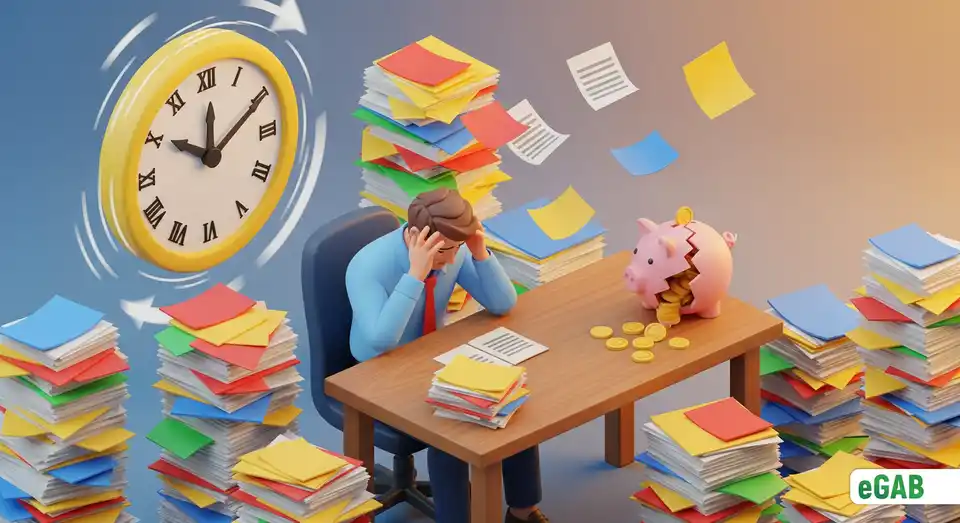
How to Prepare Your Documents for Archiving
Staring at a mountain of paperwork? We get it. It can feel overwhelming. But this first step-getting everything prepared-is the most critical part of the entire process. If you get this stage right, everything that follows becomes much easier.
First things first, you need to see exactly what you’re dealing with. Gather all your paper documents into a single, centralized location . As you do this, leave no stone unturned; check every desk, forgotten box, and dusty cabinet. Once you have it all, designate a large, clear workspace to use only for sorting. This step is key because it prevents your newly organized piles from getting mixed back into the chaos. Now, you can begin the official document sorting process . It's time for triage. You're going to sort every single document into three clearly labeled categories: "Keep," "Shred," and "Uncertain." This simple act is your first real victory over the mess. It’s also a powerful defense against the clutter that causes 7.5% of all documents to disappear.
Now, before you touch that "Keep" pile, you need a solid game plan. This pile is the core of your project: archiving old records that are still valuable to your business. This is the point where you'll establish a clear retention policy , also known as a records retention schedule. But what is a document retention schedule , exactly? While it sounds formal, it’s really just a set of rules for your organization. The policy defines how long you need to keep certain types of documents for legal or business reasons, preventing your files from becoming a legal time bomb, and it directly answers the crucial question: how long should you keep important paper documents? To make sure your policy is solid and defensible, align it with well-established standards. A great example to follow is ARMA's Generally Accepted Recordkeeping Principles® (ARMA is the leading professional association for records management).
Does a document contain sensitive information and is it past its expiration date? If so, shred it securely right away. This act of purging documents is non-negotiable for good information hygiene, and proper document shredding / secure disposal is the only way to do it safely. This simple action helps protect you from potential data breaches and other security risks and keeps your organization compliant. And what about that "Uncertain" pile? Don't let it stall your progress. Simply set a future review date for those items (say, in 30 days) to make a final decision. This strategy keeps your momentum going.
Try This: Use different colored sticky notes for your sorting piles. It's a simple visual trick that can work wonders. For instance, you could use green for "Keep," red for "Shred," and yellow for "Uncertain." This makes it easy to see your progress at a glance and helps keep you motivated.

How Do You Design an Effective Filing System?
So, your documents are sorted. Great! The next step is to build a logical and intuitive structure for them. When you get this right, you can find exactly what you need in seconds-not the 18 minutes it takes the average person to hunt down a paper document. This whole process is what we call an office filing system setup , and it's absolutely crucial to do it well.
This brings up a big question: what is the most effective way to organize paper documents? The secret is to select a primary filing method that feels natural for your team. It needs to match how you and your colleagues already think when you search for information. There’s no single "best" way; it's all about what works for you. What a huge corporation does might be total overkill, so focus on creating a simple and effective small business filing system if that's your reality. The most popular and effective methods are:
- Alphabetical: Perfect for organizing files by a client's or employee's name.
- Chronological: By date, which is ideal for things like invoices or project timelines.
- Numerical: Using a unique ID, like a client or case number, for each file.
- Categorical/By Subject: Grouping documents by department ("Finance") or topic ("Marketing Campaigns").
To keep your new system from collapsing into chaos, you need to create a master index or a "file plan." Think of this as the official map to your entire archive. This plan is the definitive guide on how to file business documents in your company. It clearly answers the question, 'what categories should I use for filing documents?' , making sure everyone is on the same page. Your file plan becomes the single source of truth for the whole team. It will slash the human errors that cause misfiled documents. Remember how professionals can waste up to 50% of their day just looking for information? A clear file plan gives them that time back.
Finally, whatever you decide, keep the system as simple as possible . It’s tempting to build a super-complex system with dozens of sub-folders, but those systems are a nightmare to maintain. Before you know it, your team will just ignore it. Always start with broad categories. You should only create more specific sub-folders when you absolutely have to.
Why It Matters: Your filing system should work for you, not the other way around. Be sure to choose the method that feels the most intuitive. For a sales team, filing records alphabetically by client name just makes sense. But for an accounting team, organizing everything by date or invoice number is far more logical. Ultimately, the right system is the one your team will actually use consistently.
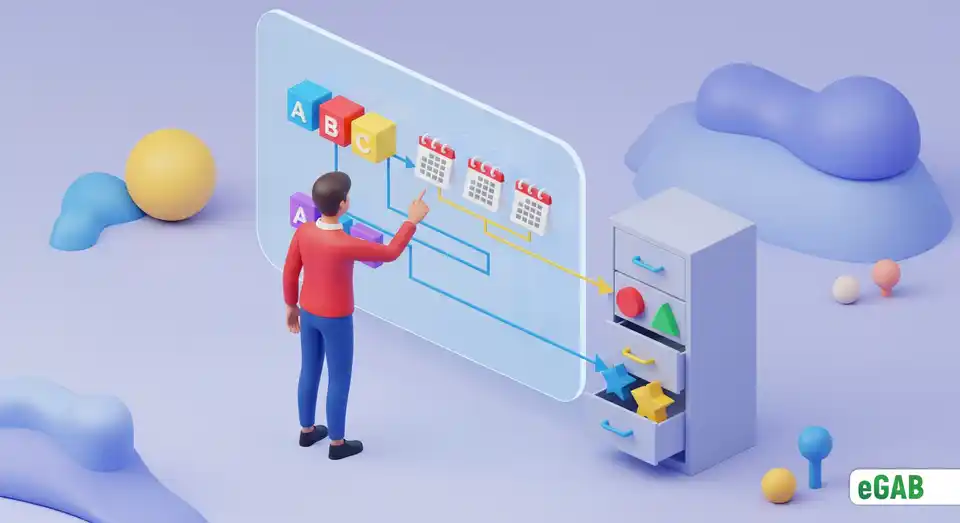
A Fully Integrated Digital Wallet for Students
So, the university issues a secure digital diploma-what happens next? This is where the eGAB Wallet comes in. It’s not just another app; it's a crucial part of the ecosystem, designed with the student’s entire professional journey in mind. Think of it as a super-secure digital portfolio where students can get, store, and most importantly, share their verified credentials with anyone, anywhere, at any time. Because these aren't static PDF files; they're dynamic digital assets. Students can instantly share their credentials straight from the wallet to platforms like LinkedIn , or send them by email or even through messaging apps like WhatsApp.
But the real magic is in the instant verification. When a potential employer, another university, or a licensing board receives a credential shared from the eGAB Wallet, they don’t have to wonder if it's authentic. There's no need to make phone calls or send emails back to the university to check if it's real. Instead, they can verify the credential instantly just by scanning a QR code or clicking a secure link. This process, detailed further in Why Blockchain and NFTs Are Essential for Credential Verification, connects directly to the CREST Chain , confirming in real-time that the document is legitimate and hasn't been altered at all. We call this “Trust at a Click,” and it completely eliminates the slow, frustrating, and often costly verification processes that still plague the professional world today.

How to Maintain and Secure Your Organized Archive
You’ve done the hard work of creating an organized archive-and that's a huge win! But how do you maintain an organized filing system for the long haul? Now it's time to protect that investment with smart maintenance and security. Without them, even the best system can slide right back into chaos.
First, you need to stay ahead of the clutter. Schedule regular archive reviews -quarterly or annually is perfect. This is your dedicated time to purge documents that have passed their retention date. Doing this keeps your archive from getting bloated and slashes your compliance risks. Failing to meet standards, from FTC rules to HIPAA for health records, can lead to serious penalties. That's why this is a core principle of good information governance . To make sure it gets done, designate an "archive manager." This gives one person the formal responsibility for keeping the system clean and orderly. A little accountability goes a long way in keeping things straight.
To solve the age-old mystery of vanishing files, implement a check-out/check-in system . You can use tools like "out-guides"-those plastic markers you slide into a folder's spot-or even a simple logbook. The goal is simple: track who has a file and when it's due back. This one habit is your best defense against the 7.5% document loss rate that plagues so many offices. For your most critical files, you need to take security a step further. This is where secure document storage is non-negotiable, and it answers the question: how can I securely store sensitive or confidential papers? Your best bet is to store any irreplaceable or sensitive documents in a locked, fireproof cabinet . A high-quality fireproof safe is also a fantastic choice for your most valuable items. This protects them from disaster and theft as part of a disaster-proof document strategy, and it can save you the potential $220 it costs to reproduce a single lost document.
Finally, restrict access to the central archive to authorized people only. The fewer hands you have in the system, the easier it is to maintain its integrity. This simple step also prevents the frustration that leads 83% of employees to just give up and recreate a document they can't find.
Next Step: Ready to take your system to the next level? Think about digitizing your most critical documents. You don't have to scan everything overnight. Start with a " scan-on-demand " policy for your most important files, scanning them only when they're requested. This approach gives you a secure digital backup of your valuable records, ...makes your information instantly accessible to remote teams, addressing a key reason why paper-based offices fail them, and slowly reduces your reliance on physical paper.
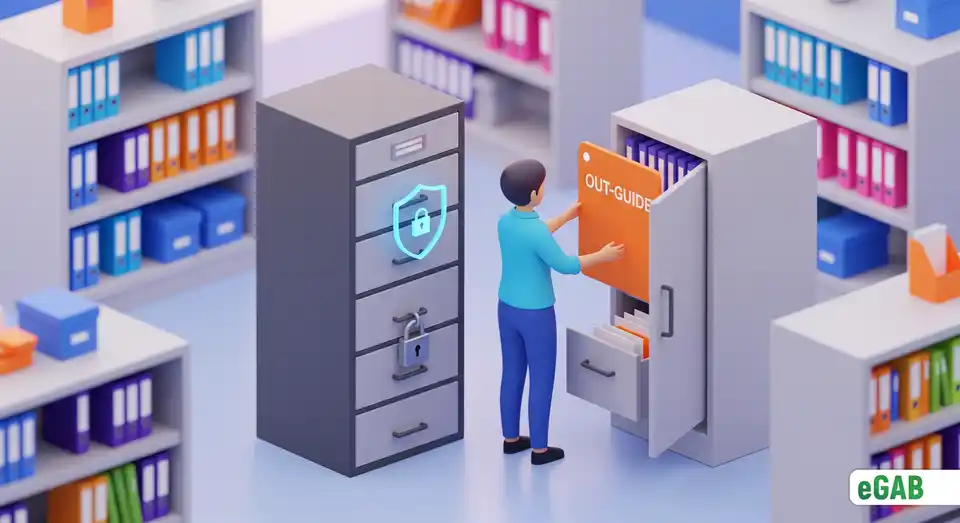
How eGAB Makes Document Organization Effortless and Intelligent
Are your filing cabinets a chaotic maze of inconsistent labels and misplaced folders? Let's be honest: the manual organization of paper documents is a battle you just can't win. It’s riddled with human error and creates information silos that paralyze your efficiency. eGAB moves beyond this physical chaos by creating a smart, digital archive that's perfectly organized from day one.
With eGAB, you can find and authenticate any verifiable document in seconds using a simple search or a quick QR code scan. That means no more lost files or hours spent digging through dusty boxes. The platform also automates the entire document lifecycle management. It handles issuance, updates, and access rights programmatically, so you’ll never need to do any manual filing, sorting, or labeling again.
Best of all, the blockchain automatically creates a permanent, chronologically accurate, and unchangeable record of every single document you issue. The result? A perfectly organized digital archive that requires zero administrative effort to maintain. It replaces the endless, frustrating chore of physical organization with intelligent, automated order.
Takeaway: A physical filing system's value degrades over time as human error inevitably creeps in. A blockchain-based archive only becomes more secure and valuable. It’s a system designed for perfect, permanent order.

Summary: Transforming Paper Chaos into a Secure and Efficient Asset
So, let's bring it all together. You've walked through the complete journey, which started with a frustrating reality: a disorganized paper archive that's a major drain on your business. It costs you thousands in lost productivity and creates a constant risk of data loss. The core takeaway is this: taking control of your documents isn't just a tidying-up exercise. It's a vital strategic move to reclaim your time, secure your company's knowledge, and protect your bottom line.
The solution is a methodical, four-part approach that successfully transforms that chaos into a system that actually works. It all begins with thorough preparation . This means gathering every document and sorting them into "Keep," "Shred," and "Uncertain." Most importantly, you need to establish a clear document retention schedule based on professional standards, like those from ARMA , to guide what you keep and for how long.
Once you know exactly what to keep, the next crucial step is to
design an effective office filing system
. You'll choose a primary method-like alphabetical, chronological, or categorical-and then carefully document it in a master file plan. This creates a single source of truth that everyone can follow, and it's this simple logic that gives you back those valuable hours you lost to searching. From there, you'll focus on execution with
best practices for labeling and storage
. Using a label maker for clear, consistent formats (like
CATEGORY - Sub-Category - Year
) is key, and you'll also want to implement a helpful
color-coded filing system
. Choosing sturdy, archival-safe storage solutions is what turns your logical plan into a secure, easy-to-navigate reality.
Finally, to protect all your hard work, you have to diligently maintain and secure the archive . This process means scheduling regular purges, appointing a dedicated archive manager, and implementing a reliable check-out system to stop files from vanishing. For your most sensitive information, use secure document storage like locked, fireproof cabinets. By following these steps, you build more than just organized shelves. You create a reliable, efficient, and secure asset that actively serves your business instead of holding it back.
➡️ What's the ultimate solution? A tidy filing cabinet is good, but it's not the future. To truly solve these problems, you need a new paradigm. Read our beginner's guide to Verifiable Credentials.
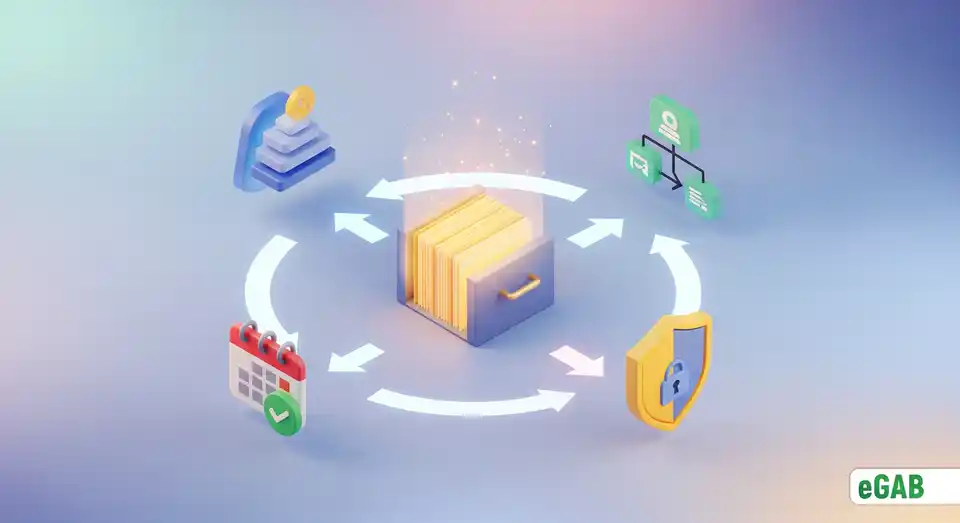
The Ultimate Bottleneck: How Paper-Based Processes Are Killing Your Business Automation
What Are Verifiable Documents? A Beginner's Guide to the Future of Trust
Why Public NFT Platforms Are the Wrong Choice for Academic Credentials
Why an In-House Credential Verification System Is a Mistake for Universities
The Anatomy of a Fake: A Deep Dive into Modern Document Forgery
